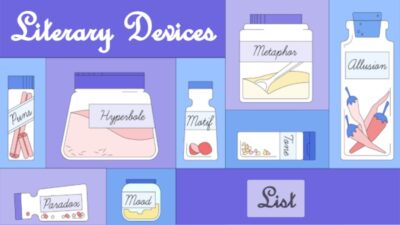
Rhetorical strategies list 2023 with examples are available online. It includes techniques or methods used in communication to persuade, influence, or engage an audience. Rhetoric Devices, or strategies, involve the deliberate use of language, style, and structure to make a point effectively. Some of the common rhetoric strategy for creative writing or speaking includes irony, amplification, metaphor, simile, hyperbole among others.
Commonly Used Rhetorical Strategies
Rhetorical strategies are the writing techniques that authors use to convince the audience of their purpose. Good writers figure out their purpose for writing and determine which rhetorical strategies will help them fulfill it. Here are some commonly used rhetorical strategies:-
- Amplification: Amplification builds on a word, phrase or sentence, evoking a sense of urgency and intensity in the reader or listener. Take this example for instance:
Example: “They want a perfect house in a perfect neighborhood”.
The repetitive use of ‘perfect’ in the example highlights the importance of finding the right home and place to live. - Anacoluthon: An anacoluthon is used to introduce a sudden change in ideas or sometimes seemingly unrelated topics in the middle of a sentence. This device is commonly used to add emphasis on the ideas or topics being expressed in a conversation. The following example from Shakespeare’s King Lear showcases how you might use it in your communication.
Example: “I will have such revenges on you both, that all the world shall―I will do such things, what they are, yet I know not.”
Shakespeare’s character interrupts himself in the middle of the sentence, almost seemingly into an unrelated topic. However, he is still speaking of revenge, but with the use of anacoluthon, the original idea is cut off, provoking the reader to guess at what the character may have been about to say. - Analogy: Drawing comparisons between two different things to help the audience understand complex or abstract concepts by relating them to something familiar.
Example: “Just as a caterpillar transforms into a butterfly, we too can undergo personal transformation.” - Anadiplosis: This device uses the same word at the end of a sentence and the beginning of the next sentence. Used this way, the anadiplosis allows a chain of thought to carry through to the next idea, allowing your audience to follow along with the point you are presenting. Using a repetitive approach allows the listener to follow along the path of your ideas. Here is a famous example of anadiplosis as the character Yoda uses it in Star Wars: The Empire Strikes Back:
Example: “Fear leads to anger. Anger leads to fear. Fear leads to suffering.”
Using this strategy can help to put more emphasis on the ideas being conveyed, allowing your conversation to stress the importance of your ideas. - Alliteration: The repetition of consonant sounds at the beginning of words in close proximity, which adds rhythm and musicality to the language.
Example: “Peter Piper picked a peck of pickled peppers.” - Antanagoge: An antanagoge uses a negative and positive statement in one. You can use this rhetorical device to present a problem and a subsequent solution. When used appropriately, this strategy can allow for a well-developed and persuasive approach to communication, whether in writing or everyday conversation. Consider the following, well-known example of antanagoge:
Example: When life gives you lemons, make lemonade.
This quote conveys the negativity in having a bunch of lemons with its subsequent solution, making lemonade from all of it. Another example of common usage of the antanagoge device: The house is old and worn, but it’s clean and sturdy. The device works here by presenting what could be considered a problem, and then providing a positive viewpoint (or solution) to the earlier negative statement. This can sometimes be a useful device in speeches. - Apophasis: This device works in a similar way as irony, where you might say something while denying it. You might use a common phrase such as “I am not saying that…” but then follow it up with a statement that you just mentioned you were not saying. Consider the following example to help highlight how this strategy works:
Example: I’m not saying that it is your fault, but you were the one who broke the vase.
Here, the speaker is not overtly blaming the listener for breaking the vase but is saying that the listener caused it in some way. - Anaphora: Repetition of a word or phrase at the beginning of successive clauses or sentences to create emphasis or reinforce a particular point.
Example: “We shall fight on the beaches, we shall fight on the landing grounds, we shall fight in the fields and in the streets.” - Chiasmus: Chiasmus is a rhetorical technique where the speaker changes the order of the words or phrases in a sentence to invoke a sense of powerful emotion. This device works by allowing the listener to have an emotional thought response to what is being said. One of the most well-known and powerful examples of this rhetorical device can be heard in President John F. Kennedy’s inaugural speech:
Example: “Ask not what your country can do for you—ask what you can do for your country.”
He used this device to provoke deep thought as well as to make a personal connection between the population and their roles within the American nation. - Euphemism: Euphemism is a rhetorical device that uses a pleasant phrase or saying to convey a more familiar or less pleasant one. Consider the following examples of euphemisms at work:
Example: 1) “Culturally deprived environment” can serve as a stand-in for “slum” or “poor neighborhood.” 2) “Domestic engineering” can be used as a euphemism for “house cleaning.” 3) “Genuine imitation leather” can serve as a euphemism for “fake leather” or “vinyl.” - Hyperbole: Exaggerating statements for emphasis or dramatic effect. It is often used to create a strong emotional response in the audience.
Example: “I’m so hungry I could eat a horse!” - Hypophora: This rhetorical strategy is used when a writer or speaker asks a question and then immediately provides the answer. You might have already found yourself using this device when in conversation or other communication. Here is an example:
Example: Why is it important to eat healthy foods? It is important because you can heal illness and build your immune system.
Unlike a rhetorical question, a hypophora wastes no time in providing a direct answer to a posed question. - Irony: Saying the opposite of what is meant, often for humorous or sarcastic effect.
Example: “Oh, wonderful! Another rainy day in paradise.” - Metaphor: Using figurative language to make a comparison between two unrelated things, often to evoke imagery or convey a particular meaning.
Example: “Time is money.” - Parallelism: Using parallel grammatical structures or patterns to create balance and rhythm in a sentence or series of sentences.
Example: “I came, I saw, I conquered.” - Rhetorical question: Asking a question that does not require an answer but is posed to make a point or engage the audience in thinking about a particular topic.
Example: “Are you ready to take a stand for justice?” - Repetition: Repeating words, phrases, or ideas for emphasis or to create a memorable impact. It can help reinforce a message and make it more persuasive.
Example: “I have a dream” – Martin Luther King Jr.’s famous speech. - Similes: These devices work by invoking a sense of comparison between two like subjects. Similes work to provide a comparable point-of-view to a well-known or familiar subject. Consider the following examples:
Example: 1) He was as hungry as a lion. 2) The children were as loud as a pack of wild dogs. - Ethos: Ethos is the appeal to ethics, or the speaker’s credibility or values. Writers want to appear knowledgeable about their subject, so they will highlight their expertise while writing to let the audience know that they are credible. Further, writers will appeal to moral values or principles.
Example: Politicians often refer to the values in their speeches such as “Over the past twenty-five years, I have worked persistently on issues relating to women, children, and families. Over the past two and a half years, I’ve had the opportunity to learn more about the challenges facing women in my own country and around the world”. - Pathos and Logos: It appeals to emotions and logos appeals to logic and reason. Skilled speakers or writers often use a combination of these appeals to persuade their audience effectively.
These are just a few examples of rhetorical strategies. Skilled communicators use a variety of techniques to achieve their intended effect and engage their audience. Use of rhetorical devices can serve to add animation to your conversations, and when you apply the use of strategies like these, you may also develop different approaches to your communication.










